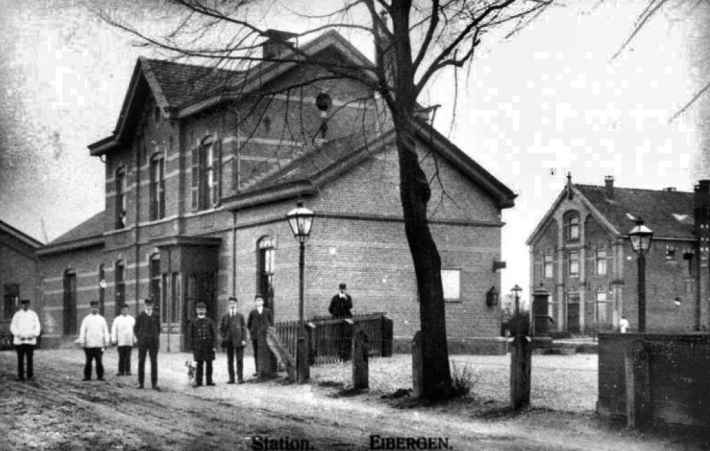Module Eybergen

My module Eybergen is very losely inspired by the former station of Eibergen of the Geldersch-Overijsselsche Local Railway Company GOLS. (Hence Eybergen instead of Eibergen). The station was located on the railway line from Neede to Winterswijk in the East of the Netherlands. It was opened on October 15th, 1884.

Station Eibergen, after 1909. On the other side of the track, on the right the former tabacco factory on the Parallelweg. Photo Historische Kring (Historic Circle) Eibergen
With the rise of local transport by bus, the GOLS stopped the passenger service on this line already in 1937. The station building was still used as a private residence for some time, but in 1956 it was demolished. Up to 1974 freight trains kept using the route Winterswijk - Borculo. Afterwards the freight shed was also torn down.

A photo of the module during construction.
On the module only the station building with it's drive and the freight shed on the right are according to reality; the rest is complete fantasy. The small harbour of Eibergen was located much further away, on the river Berkel. And such large barges have never sailed there. The aim of the module was to depict reality as best as possible. I started the 'box' to try out various modelling techniques, like laying ballast and pooring resin for water.

Photo of the 2nd class waiting room of station Winterswijk; year unknown
Photo: commons.wikimedia.org (search for station winterswijk)
Technical details of the module:
- sizes 50 (d) x 100 (w) x 19 (h) cm
- build according to quite liberalized FREMO conditions
- scale h0 (1:87)
- rails old Fleischmann Modellgleis (h0) and new Roco light railway tracks (h0e); the 'fork' between both types of track is hand made from a modified Joeuf switch
- lighting 15V, with in series connected 4,5 V LEDS
*) For the connoiseurs; the station was of the type 'GOLS large', with a main building and a lean-to freight shed. In 1909 a second wing was added on the other side, with an extra waiting room. The still existing station of Groenlo is of the same type.

The model of the station building, with in the foreground the 3D printed windows and doors.
The station and freight shed are made of cardboard with glued on prints of bricks reduced to scale. Before printing the yellow strips, the relieving arches above the windows and doors and wall anchors were added in Photoshop.
The windows and doors themselves and the vestibule of the waiting room at the back have been 3D-printed, with help of the original building drawings.
The roof of the station is a standaard plastic building plate by Faller that has been painted; the 'asphalt' roof of the shed is made of strips of painted paper.
The loading dock for pit coal is a strongly modifeid 'Master building kit' by Pola (nr 671). The barge was handmade from mainly balsa wood and cardboard.
As I wanted to add interior lighting I decided to add simple interiors. But that escalated 'a bit'. They became so detailled, that they are now exhibited separately at the front of the module apart. As the station looked quite bare and empty afterwards, it got its simplefied versions of the interior after all.

Detail photo of the buffet in the waiting room. This space was modelled after the photo in the lower left.
The funniest aspect of Eybergen - especially for children from 4 to 99 years of age - are the many small details and jokes that have been added to the module: e.g. a cat is being rescued from a sewer, a seal is swimming in the harbour and an octopus has settled in a sunken rowing boat. In the reeds on the left a man is taking a leak. But whether that was a good idea?

Detail on the left hand side of the module.